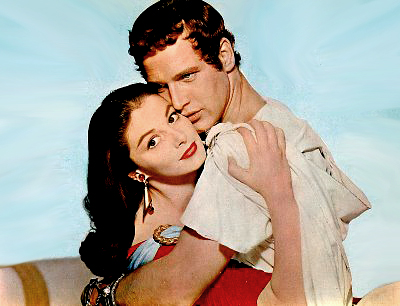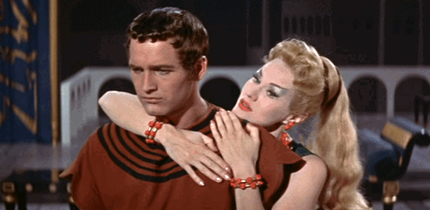
 |
|
|
|
A wholly unexpected TV event occurred in 1966 when the 1954 Warner Bros. movie The Silver Chalice was scheduled to be broadcast in Los Angeles. Star Paul Newman took out an ad in the trade papers to ask people not to watch his first movie, which he considered a complete embarrassment. The ad was a win-win proposition. A bigger audience tuned in to find out what the big deal was, and Paul Newman cemented his reputation as a Hollywood pro with a healthy sense of humor. 
The Silver Chalice is a quasi-Biblical epic in the vein of Quo Vadis and Ben-Hur, fictional stories related to Jesus Christ or the early days of Christianity. Produced in CinemaScope, WarnerColor and stereophonic sound, it's ponderous and unintentionally amusing. The cast guarantees that things won't get dull: various scheming characters include Jack Palance and Joseph Wiseman. Like the huge hit The Robe, author Thomas B. Costain's story centers on a Christian relic endowed with miraculous spiritual power. The cup that Jesus drank from at the Last Supper doesn't heal the wounded or raise the dead, but it glows when viewed by Christian believers. Soon after the young Greek sculptor Basil (Paul Newman) drinks from it, he is spiritually converted to the new faith. Raised in the Roman city of Antioch, Basil is cheated out of his birthright when a treacherous relative (Herbert Rudley) sells him into slavery. Help comes from two sources. A group of Christians in Jerusalem asks Basil, now a talented silversmith, to fashion a chalice holder for the revered cup of Jesus. He soon attracts the eye of his sponsor's beautiful daughter Deborra (Pier Angeli). But long ago Basil helped the young slave girl Helena (Natalie Wood) to escape. Now grown to adulthood (as Virginia Mayo!), the lustful Helena plans to make Basil her midnight consort, despite her marriage to the wondrously skilled magician Simon Magus (Jack Palance). Basil, Deborra, Simon and Helena eventually travel to Rome, where Basil seeks out Saint Peter (Lorne Greene, also in his first movie). The fanatic Mijamin (Joseph Wiseman of Dr. No), enlists Simon to recruit Jesus' followers for a revolt against the Romans. Simon's power-mad ambitions lead him to ask Emperor Nero (Jacques Aubuchon) to build a tower 200 cubits tall. The obelisk will enable Simon to pull off a fake "miracle" that will convince the ignorant masses to abandon Jesus. But Simon's megalomania gets out of control: he becomes so wrapped up in his superstar status that he begins to believe he can fly without aid of magic tricks. 
Screenwriter Lesser Samuels had previously contributed dialogue to the odd Christian allegory Strange Cargo. The Silver Chalice is weighed down by awkward exposition, and Victor Saville's static direction does little more than instruct the actors to stand still while delivering speeches. The continuity is rough as well. At one point the love-struck Deborra seems to be describing a scene that had to be dropped: "I cannot believe I am home again. When you awakened me in Miriam's cottage I thought it was a dream." Virginia Mayo's sultry Helena is given the worst line of all: "Hail Lucius Niger, my curly-headed ram!" Production designer Rolf Gerard's unusual sets seem more appropriate for a stage opera, as are some of the abstract costume designs. Huge interiors have featureless walls and oversized doors. Some full-scale settings look like cardboard cutouts. Painted backdrops resemble something out of Dr. Seuss or a flattened-perspective UPA cartoon; Basil's view of a field of crucified Christians is a complete abstraction. The overall effect is a strange artificiality -- many scenes look like raw conceptual storyboards. 
Paul Newman is actually quite good considering the essential dullness of the character he plays. We can imagine the actor watching James Dean make movie history in the soundstage next door, and then tossing in his sleep convinced that his career could be over before it begins. The interesting supporting cast is in desperate need of good direction. Trying to underplay their roles are Alexander Scourby, Michael Pate and E.G. Marshall (wearing a heck of a nice beard). Fringe benefits include appearances by Robert Middleton, Ian Wolfe, Strother Martin, Norma Varden and Mel Welles. Playing a Roman armorer, Albert Dekker's voice is just too bombastic. Lorne Greene works too hard to telegraph his piety. He recites an awkward, inspirational curtain speech that predicts a perilous future world where men will indeed fly, and the teachings of Jesus will be needed more than ever. Could he possibly be talking about... us? The gorgeous Virginia Mayo is made to wear some of the most unattractive eye makeup in film history. She unfortunately comes off as an overdone burlesque queen. The lovely Pier Angeli projects a strong sense of virtue that supports the Christian theme. Still, we can't help but question the film's morality. Basil and Deborra enter a marriage of convenience that will allow Deborra to gain direct control of her inheritance, and spend it all on Christian good works. Besides the dishonesty (and blasphemy!) involved, the focus on money is not very flattering. It may have reminded viewers of the big upswing in postwar evangelism and its emphasis on soliciting mass donations. In the Jerusalem crowd scenes, Jews and Christians alike behave like sheep, following whoever tells them what to believe. Messiah or charlatan, it doesn't seem to matter. 
The heavy hitters in the cast are actors Joseph Wiseman and Jack Palance. Wiseman's terrorist leader spouts rhetoric meant to blend fascist arrogance with communist cynicism -- he comes off as an utter fanatic. As the crazy magician-turned false messiah, Palance overacts with gusto. Simon's spectacular miracle show must be seen to be believed. Palance straps on a pair of bat-wings over a foolish-looking leotard, a get-up that makes him look exactly like Wile E. Coyote trying out a new purchase from the Acme mail order company. Only Palance could get away with Simon's enthusiastic statement, when he comes to believe his own PR hokum: "I need no wires, no buckles! I need no wheel to be turned! I shall fly by the power of my own will, and all the world will wonder and worship!" Paul Newman's newspaper ads had a point, as The Silver Chalice now plays as a strange artifact from the 1950s, in questionable taste. Viewers looking for a respectable Christian-oriented tale might be disappointed. But the film's mix of undigested cultural themes is irresistible. It's obvious that the filmmakers' intentions are dead serious, which makes the many funny lines and absurd situations all the more entertaining. 
The Warner Archive Collection disc of The Silver Chalice is advertised as "Back In Print." It appears to be identical to the excellent standard DVD released in 2009, carrying the same menus, the same chapter stops, and the same 5.1 surround audio configuration. The WarnerColor appears not to have faded. The only noticeable jump in picture quality occurs when optical dissolves are cut in, a flaw sourced from the original film elements. Franz Waxman's Oscar-nominated music score sounds very rich and full; it has enjoyed a respectability denied the movie itself. Warners inadvertently threw away the stereophonic tracks for Chalice and many other '50s titles decades ago. In the 1990s most of them were restored by accessing magnetic-striped prints deposited with the Library of Congress.
On a scale of Excellent, Good, Fair, and Poor,
The Silver Chalice rates:
Reviews on the Savant main site have additional credits information and are often updated and annotated with reader input and graphics. Also, don't forget the 2011 Savant Wish List. T'was Ever Thus.
Review Staff | About DVD Talk | Newsletter Subscribe | Join DVD Talk Forum |
| ||||||||||||||||||